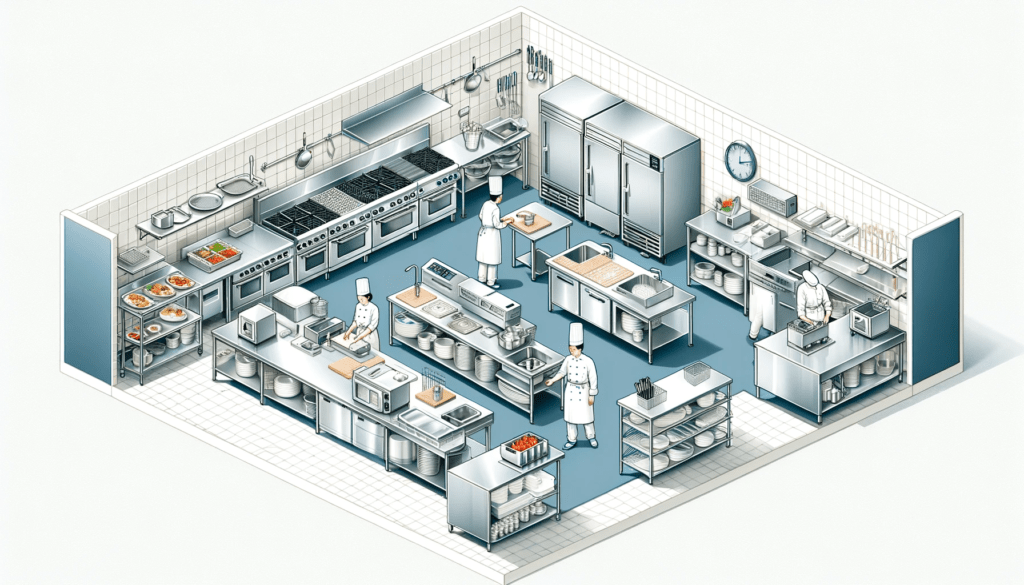How to Set Up a Commercial Kitchen
Setting up a commercial kitchen is a complex but exciting venture, combining culinary passion with practical design and regulatory considerations. In this comprehensive guide you will learn how to set up a commercial kitchen and you will know how to keep it safe.
Understanding the Basics of kitchen.
Before diving into specifics, it’s essential to understand what differentiates a commercial kitchen from a home kitchen. Commercial kitchens are designed for large-scale food preparation, requiring robust equipment, larger space, and adherence to stringent health codes. They are commonly found in restaurants, hotels, hospitals, educational institutions, and other facilities.
Step 1: Planning and Design
Assess Your Needs
Start by evaluating your menu, service style, and the expected volume of business. These factors influence the type of equipment you need, the layout of the kitchen, and storage requirements.
Designing the Layout of kitchen
The layout of a commercial kitchen should facilitate a smooth workflow. Common designs include the assembly line layout (ideal for kitchens that need to serve a large number of similar dishes quickly), the island layout (centralizing cooking equipment), and the zone-style layout (dividing the kitchen into different activity areas).
Space Considerations for kitchen
Ensure there is ample space for food preparation, cooking, dishwashing, storage, and receiving deliveries. Don’t forget to allocate space for walkways and emergency exits.
Step 2: Equipment Selection
Cooking Equipment
Select commercial-grade stoves, ovens, fryers, and grills based on your menu requirements. Remember to consider the power supply (gas or electric) in your kitchen.
Refrigeration
Invest in commercial refrigerators and freezers that meet your capacity needs. Consider the layout and frequency of use to decide between reach-in or walk-through models.
Food Preparation Equipment
Include mixers, blenders, slicers, and other specialty equipment. The size and capacity should match your expected output.
Storage and Shelving
Opt for stainless steel shelving, as it’s durable and easy to clean. Ensure there is enough shelving for dry goods, perishables, and non-food items.
Safety Equipment
Install fire extinguishers, fire suppression systems, and first-aid kits. Ensure all staff are trained in their use.
Step 3: Ventilation and Lighting of kitchen
Ventilation Systems
Invest in a high-quality ventilation system to manage heat, smoke, and odors. This includes hoods, fans, and fire suppression systems.
Lighting
Good lighting is crucial for safety and efficiency. Opt for bright, energy-efficient LED lights.
Step 4: Health and Safety Compliance
Local Health Codes
Familiarize yourself with local health and safety regulations. These often dictate equipment specifications, food handling procedures, and sanitation requirements.
Sanitation
Install multiple handwashing stations and ensure there are adequate facilities for cleaning equipment and utensils. Use non-porous surfaces for easy cleaning.
Pest Control
Implement a pest control plan to prevent infestations. This includes regular inspections and proper food storage practices.
Step 5: Technology and Efficiency
Point of Sale (POS) Systems
Integrate a POS system that can handle orders, billing, and inventory management efficiently.
Energy Efficiency
Select energy-efficient appliances to reduce costs and environmental impact. Consider the Energy Star ratings when purchasing equipment.
Waste Management
Implement a waste management system to handle food waste, recyclables, and general waste efficiently.
Step 6: Staffing and Training
Hiring Skilled Staff
Hire experienced chefs, cooks, and kitchen assistants. Consider their expertise in relation to the cuisine and style of your establishment.
Training
Provide comprehensive training on equipment use, food safety, and emergency procedures.
Step 7: Final Steps and Opening kitchen
Testing and Adjustments
Before opening, test all equipment and systems. Conduct a few trial runs to ensure everything runs smoothly.
Marketing and Promotion
Develop a marketing plan to promote your new kitchen’s capabilities, whether it’s a restaurant opening or an expansion of services.
Continuous Improvement
Regularly seek feedback from staff and customers. Be prepared to make adjustments to improve efficiency and service quality.
Conclusion
Setting up a commercial kitchen is an intricate process requiring detailed planning, investment in quality equipment, and adherence to health and safety standards. By following these steps, you can create a kitchen that not only meets regulatory requirements but also supports efficient, high-quality food preparation. Remember, a well-designed commercial kitchen is the heart of any food service establishment, and its success lies in meticulous planning and execution.





